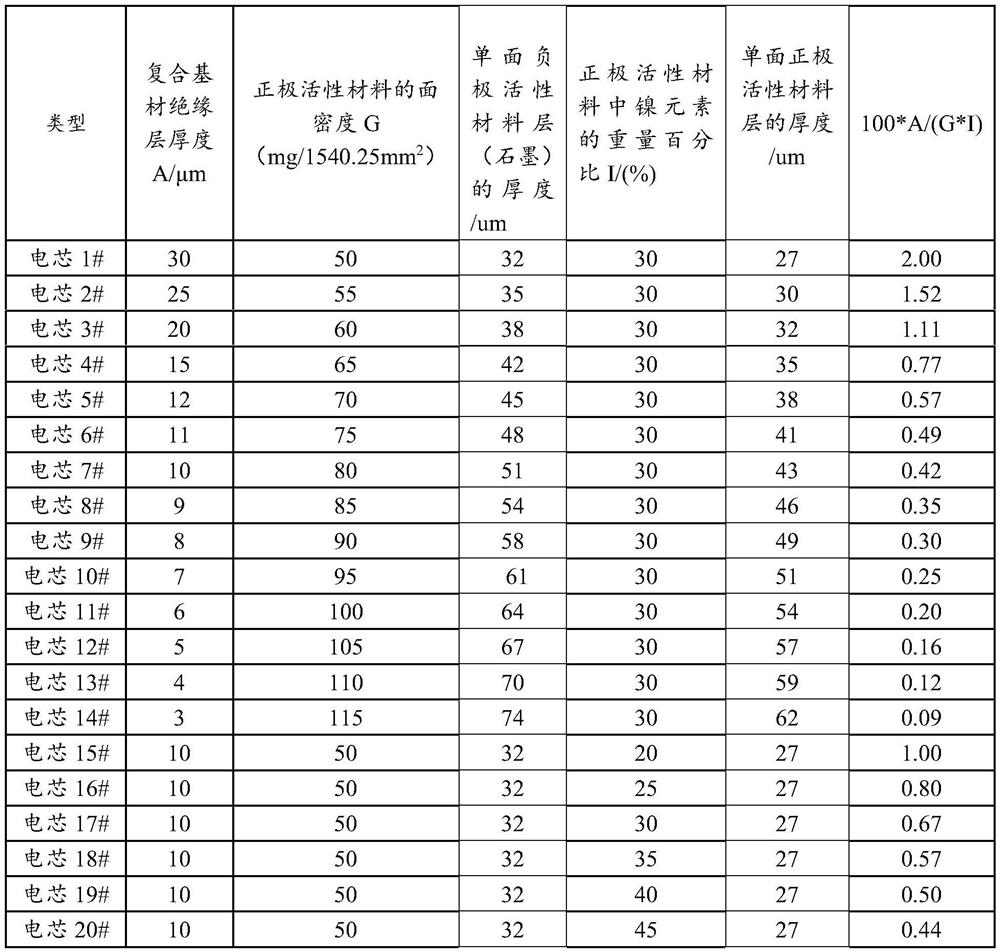Battery cell, battery module and battery pack
A technology of battery cells and winding cores, which is applied in the manufacture of electrolyte batteries, non-aqueous electrolyte batteries, secondary batteries, etc., and can solve problems such as easy short circuit of batteries and thermal runaway of batteries
- Summary
- Abstract
- Description
- Claims
- Application Information
AI Technical Summary
Problems solved by technology
Method used
Image
Examples
Embodiment 1-20
[0049] Examples 1-20 respectively provide 20 kinds of cells (cells 1-20), the thickness A of the insulating support layer 111 of the 20 kinds of cells, the areal density G of the positive electrode active material, and the weight percentage of nickel in the positive electrode active material. The relationship among the three is shown in Table 1. Meanwhile, the positive electrode current collectors and the insulating support layers 111 of the negative electrode current collectors of the 20 types of cells are made of PET, the conductive layer 112 of the positive electrode current collector is made of aluminum foil, and the conductive layer of the negative electrode current collector is made of copper foil. The active particles of the positive electrode active material are nickel cobalt lithium manganate. The active particles of the negative electrode active material are graphite materials and silicon carbon materials, and graphite materials include but are not limited to natural...
experiment example 1
[0058] Acupuncture experiments were performed on 20 types of cells provided in Examples 1-20 and 4 types of cells provided in Comparative Examples 1-4 according to the procedures in the national standard GBT31485. During the test, put the cell in a constant current of 1.0C and charge it to 4.3V, and then charge it with a constant voltage until the current is reduced to 0.05C, and use a high-temperature-resistant steel needle with a diameter of 1mm at a speed of 2mm / s. The penetration was carried out in the direction of the electrode piece of the cell, and the penetration position was close to the geometric center of the acupuncture surface. The steel needle stayed in the cell and observed for one hour. The experimental results are shown in Table 3.
[0059] Table 3. Acupuncture experimental data of cells
[0060]
[0061]
[0062] According to the data tested in Table 3, it can be seen that compared with Comparative Examples 1-4, Examples 1-20 of the present invention co...
experiment example 2
[0064]The energy density test was carried out under the same conditions as the 20 types of cells provided in Examples 1-20 of the present invention and the 4 types of cells provided in Comparative Examples 1-4. Among them, the discharge energy of 1C is represented by E1, the unit is Wh; the mass of the cell is represented by m, the unit is kg, and the weight energy density of the cell is represented by W, the unit is Wh / kg. In addition, the test conditions of E1 are: in a 25°C incubator, charge at a constant current rate of 1C to a voltage of 4.3V, then charge at a constant voltage of 4.3V to a current of 0.05C, and then discharge at a constant current rate of 1C to a voltage of 2.8 V, the discharge energy E1 is obtained. The weight test condition of the cell is in the environment of 25°C, and the mass m of each cell can be obtained through the electronic scale. The weight energy density of the cell is calculated by the formula p=E1 / m, and the specific results are shown in Ta...
PUM
 Login to View More
Login to View More Abstract
Description
Claims
Application Information
 Login to View More
Login to View More - R&D
- Intellectual Property
- Life Sciences
- Materials
- Tech Scout
- Unparalleled Data Quality
- Higher Quality Content
- 60% Fewer Hallucinations
Browse by: Latest US Patents, China's latest patents, Technical Efficacy Thesaurus, Application Domain, Technology Topic, Popular Technical Reports.
© 2025 PatSnap. All rights reserved.Legal|Privacy policy|Modern Slavery Act Transparency Statement|Sitemap|About US| Contact US: help@patsnap.com



